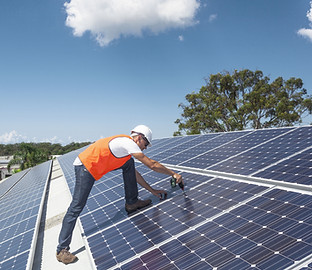

Energy Economics
Highland Economics has worked with public and private sector clients to assess the economic development potential, environmental impact, and socioeconomic implications of developing diverse energy resources, including coal, oil, natural gas, wind, solar, hydropower, and biomass. We are also experienced in evaluating the economic and market impact of energy policy, including biofuel mandates and carbon regulations. Finally, we often evaluate the current and potential future financial and economic value of carbon offsets and carbon mitigation, based on nascent carbon markets and the social cost of carbon.
Specifically, we have helped our clients through all phases of energy projects, from feasibilty analysis to economic impact assessment:
-
Economic and financial feasibilty of energy resource development or production
-
Economic impact of energy projects, in terms of regional jobs, income, taxes
-
Market analysis of local, regional, international energy demand
-
Socioeconomic, visual, and enviromental justice impacts of energy projects
(e.g, NEPA)
-
Quality of life impacts, including aesthetics, recreation, and property value impacts
-
Social cost of carbon emissions
-
Financial value of carbon credits
Selected Energy Economics Projects
Energy Capacity Assessment, New Mexico
For the Navajo Nation Department of Natural Resources, Highland principal Travis Greenwalt led a team in identifying the institutional capacity of developing energy projects on Navajo Nation, specifically related to coal development and future prospects of renewable energy generation on Navajo Nation lands. The project involved interviews with key stakeholder groups associated with various types of energy generation on Navajo Nation to identify internal strengths and weaknesses of project developments. In addition, private industry participants were also being interviewed to assess future opportunities and challenges of energy development within Navajo Nation. A financial assessment and market analysis of a select number of energy developments, including coal and geothermal projects, was also conducted as part of this study to determine economic development potential.
Economic Development Potential of Wind Power Projects, Washington
For the Southeast Washington Economic Development Authority, Highland principal Barbara Wyse conducted an economic and fiscal impact analysis to determine the socioeconomic effects of past and potential future wind power development. Through site visits, extensive interviews and data collection, Barbara estimated the effects of three wind power projects on regional jobs, income, taxes, housing, population, and recreation and tourism. Economic impacts were estimated using a regional economic model to identify how project construction and operation spending rippled through the local economy, resulting in indirect jobs and income in all sectors of othe economy. Barbara also identified concrete steps the local community could take to increase the economic benefit of wind power projects through capturing more direct and indirect project-related spending. Also, to address local concerns regarding wind development, Barbara assessed how wind projects may affect local quality of life, through such factors as property values, quality and quantity of recreation opportunties, and aesthetics. Barbara presented results at several local forums, and the final report provided the client with information on how to increase economic benefits of wind development and also addressed and assuaged public concerns regarding potential adverse impacts of wind development.
Biomass Conversion Feasibility Study and Impact Analysis, Ohio, Pennsylvania, and Missouri
Highland Economics Principals Barbara Wyse and Travis Greenwalt evaluated the economic feasibility and economic impact of several biomass conversion facilities. We evaluated the project site, reliability of the financial projections and assumptions, projected balance sheets and costs, cash flow projections for seven years, adequacy of raw materials and supplies, and overall project risk. We also prepared for each project an economic impact study estimating the total (direct, indirect, and induced) employment and income impacts of the development and operation at each of the proposed project facilities in Ohio, Pennsylvania, and Missouri. This included developing an IMPLAN regional economic impact model to evaluate ripple effects (indirect and induced impacts) associated with the increased economic activity in the agricultural and manufacturing sectors.
